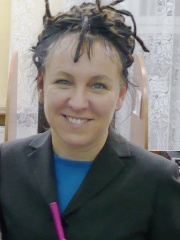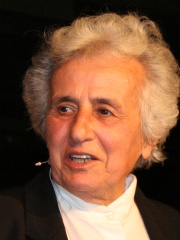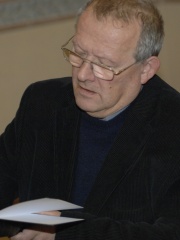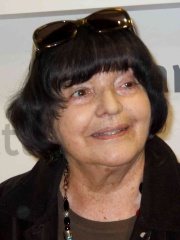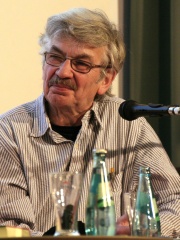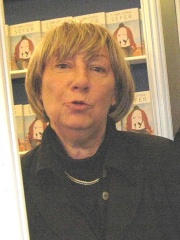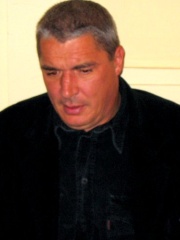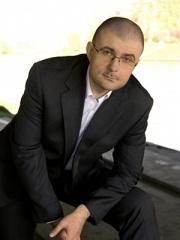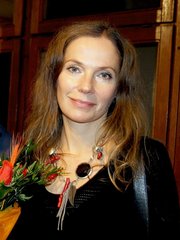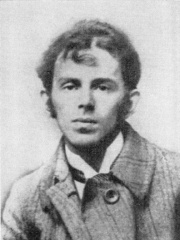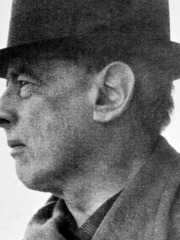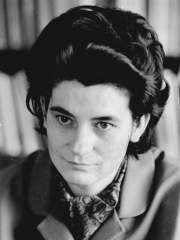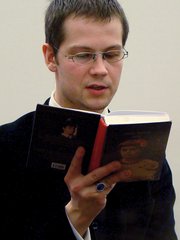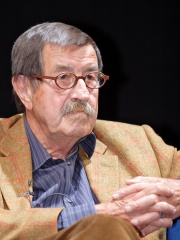
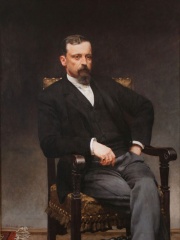
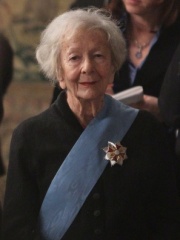
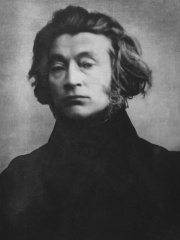
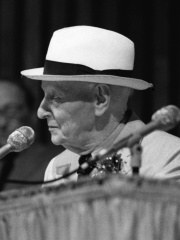
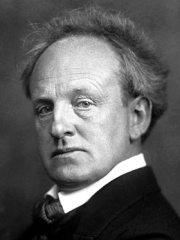

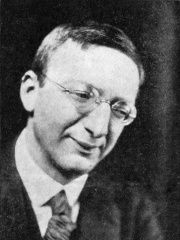
The Most Famous
WRITERS from Poland
Top 10
The following people are considered by Pantheon to be the top 10 most legendary Polish Writers of all time. This list of famous Polish Writers is sorted by HPI (Historical Popularity Index), a metric that aggregates information on a biography's online popularity. Visit the rankings page to view the entire list of Polish Writers.

1. Günter Grass (1927 - 2015)
With an HPI of 80.42, Günter Grass is the most famous Polish Writer. His biography has been translated into 113 different languages on wikipedia.
Günter Wilhelm Grass (German: [ˈɡʏntɐ ˈɡʁas] ; 16 October 1927 – 13 April 2015) was a German novelist, poet, playwright, illustrator, graphic artist, sculptor, and recipient of the 1999 Nobel Prize in Literature. He was born in the Free City of Danzig (now Gdańsk, Poland). At age 17, he was drafted into the military and served from late 1944 in the Waffen-SS. He was taken as a prisoner of war by US forces at the end of the war in May 1945. He was released in April 1946. Trained as a stonemason and sculptor, Grass began writing in the 1950s. In his fiction, he frequently returned to the Danzig of his childhood. Grass is best known for his first novel, The Tin Drum (1959), a key text in European magic realism. It was the first book of his Danzig Trilogy, the other two being Cat and Mouse and Dog Years. His works are frequently considered to have a left-wing political dimension, and Grass was an active supporter of the Social Democratic Party of Germany (SPD). The Tin Drum was adapted as a film of the same name, which won both the 1979 Palme d'Or and the Academy Award for Best Foreign Language Film. In 1999, the Swedish Academy awarded Grass the Nobel Prize in Literature, praising him as a writer "whose frolicsome black fables portray the forgotten face of history".

2. Henryk Sienkiewicz (1846 - 1916)
With an HPI of 79.31, Henryk Sienkiewicz is the 2nd most famous Polish Writer. His biography has been translated into 99 different languages.
Henryk Adam Aleksander Pius Sienkiewicz (US: shen-KYAY-vitch, -KYEV-itch, Polish: [ˈxɛnrɨk ˈadam alɛkˈsandɛr ˈpjus ɕɛnˈkʲɛvit͡ʂ]; 5 May 1846 – 15 November 1916), also known by the pseudonym Litwos (Polish pronunciation: [ˈlitfɔs]), was a Polish epic writer. He is remembered for his historical novels, such as the Trilogy series and especially for his internationally known best-seller Quo Vadis (1895–1896). Born into an impoverished Polish noble family in the Kingdom of Poland, at the time part of the Russian Empire, he began publishing journalistic and literary pieces in the late 1860s. In the late 1870s he traveled to the United States, sending back travel essays that won him popularity with Polish readers. In the 1880s he began serializing novels that further increased his popularity. He soon became one of the most popular Polish writers of the turn of the 19th and 20th centuries, and numerous translations gained him international renown, culminating in his receipt of the 1905 Nobel Prize in Literature for his "outstanding merits as an epic writer". Many of his novels remain in print. In Poland he is known for his "Trilogy" of historical novels—With Fire and Sword, The Deluge, and Sir Michael—set in the 17th-century Polish–Lithuanian Commonwealth; internationally he is known for Quo Vadis, set in Nero's Rome. The Trilogy and Quo Vadis have been filmed, the latter several times, with Hollywood's 1951 version receiving the most international recognition.

3. Wisława Szymborska (1923 - 2012)
With an HPI of 78.89, Wisława Szymborska is the 3rd most famous Polish Writer. Her biography has been translated into 101 different languages.
Maria Wisława Anna Szymborska (Polish: [viˈswava ʂɨmˈbɔrska]; 2 July 1923 – 1 February 2012) was a Polish poet, essayist, translator, and recipient of the 1996 Nobel Prize in Literature. Born in Prowent (now part of Kórnik in west-central Poland), she resided in Kraków until the end of her life. In Poland, Szymborska's books have reached sales rivaling prominent prose authors, though she wrote in a poem, "Some Like Poetry" ("Niektórzy lubią poezję"), that "perhaps" two in a thousand people like poetry. Szymborska was awarded the 1996 Nobel Prize in Literature "for poetry that with ironic precision allows the historical and biological context to come to light in fragments of human reality". She became better known internationally as a result. Her work has been translated into many European languages, as well as into Arabic, Hebrew, Japanese, Persian and Chinese.

4. Adam Mickiewicz (1798 - 1855)
With an HPI of 78.60, Adam Mickiewicz is the 4th most famous Polish Writer. His biography has been translated into 91 different languages.
Adam Bernard Mickiewicz (24 December 1798 – 26 November 1855) was a Polish poet, dramatist, essayist, publicist, translator and political activist. He is regarded as national poet in Poland, Lithuania and Belarus. He also largely influenced Ukrainian literature and affected Russian literature. A principal figure in Polish Romanticism, he is one of Poland's "Three Bards" (Polish: trzej wieszcze) and is widely regarded as Poland's greatest poet. He is also considered one of the greatest Slavic and European poets and has been dubbed a "Slavic bard". A leading Romantic dramatist, he has been compared in Poland and Europe to Byron and Goethe. He is known chiefly for the poetic drama Dziady (Forefathers' Eve) and the national epic poem Pan Tadeusz. His other influential works include Konrad Wallenrod and Grażyna. All these served as inspiration for uprisings against the three imperial powers that had partitioned the Polish–Lithuanian Commonwealth out of existence. Mickiewicz was born in the Russian-partitioned territories of the former Grand Duchy of Lithuania, which had been part of the Polish–Lithuanian Commonwealth, and was active in the struggle to win independence for his home region. After, as a consequence, spending five years exiled to central Russia, in 1829 he succeeded in leaving the Russian Empire and, like many of his compatriots, lived out the rest of his life abroad. He settled first in Rome, then in Paris, where for a little over three years he lectured on Slavic literature at the Collège de France. He was an activist, striving for a democratic and independent Poland. He died, probably of cholera, at Istanbul in the Ottoman Empire, where he had gone to help organize Polish forces to fight Russia in the Crimean War. In 1890, his remains were repatriated from Montmorency, Val-d'Oise, in France, to Wawel Cathedral in Kraków, Poland.
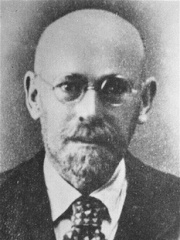
5. Janusz Korczak (1878 - 1942)
With an HPI of 77.74, Janusz Korczak is the 5th most famous Polish Writer. His biography has been translated into 56 different languages.
Janusz Korczak, the pen name of Henryk Goldszmit (22 July 1878, or 1879 – 7 August 1942), was a Polish Jewish pediatrician, educator, children's author and pedagogue known as Pan Doktor ("Mr. Doctor") or Stary Doktor ("Old Doctor"). He was an early children's rights advocate, in 1919 drafting a children's constitution. After spending many years working as a principal of an orphanage in Warsaw, he moved in with his orphans when the orphanage was forced to move to the ghetto, despite pleas from friends to flee the country. He was murdered when the entire population of the institution was sent to the Treblinka extermination camp during the Grossaktion Warschau of 1942.

6. Isaac Bashevis Singer (1902 - 1991)
With an HPI of 77.49, Isaac Bashevis Singer is the 6th most famous Polish Writer. His biography has been translated into 90 different languages.
Isaac Bashevis Singer (Yiddish: יצחק באַשעװיס זינגער; November 11, 1903 – July 24, 1991) was a Polish-born Jewish novelist, short-story writer, memoirist, essayist, and translator in the United States. Some of his works were adapted for the theater. He wrote and published first in Yiddish and later translated his own works into English with the help of editors and collaborators. He was awarded the Nobel Prize in Literature in 1978. A leading figure in the Yiddish literary movement, he was awarded two U.S. National Book Awards, one in Children's Literature for his memoir A Day of Pleasure: Stories of a Boy Growing Up in Warsaw (1970) and one in Fiction for his collection A Crown of Feathers and Other Stories (1974).

7. Gerhart Hauptmann (1862 - 1946)
With an HPI of 76.95, Gerhart Hauptmann is the 7th most famous Polish Writer. His biography has been translated into 99 different languages.
Gerhart Johann Robert Hauptmann (German: [ˈɡeːɐ̯haʁt ˈhaʊptman] ; 15 November 1862 – 6 June 1946) was a German dramatist and novelist. He is counted among the most important promoters of literary naturalism, though he integrated other styles into his work as well. He received the Nobel Prize in Literature in 1912.

8. Andrzej Sapkowski (b. 1948)
With an HPI of 73.44, Andrzej Sapkowski is the 8th most famous Polish Writer. His biography has been translated into 54 different languages.
Andrzej Sapkowski (Polish: [ˈandʐɛj sapˈkɔfski]; born 21 June 1948) is a Polish fantasy writer. He is best known for his series of books The Witcher, which revolves around the eponymous monster-hunter, Geralt of Rivia. The saga has been popularized through video games, television, stage, comic books and translated into 37 languages making him the second most-translated Polish science fiction and fantasy writer after Stanisław Lem. Described as the "Polish Tolkien", he has written multiple novels and short story collections, selling over 30 million copies worldwide. The influence of Slavic mythology is seen as a characteristic feature of many of his works. He is a five-time recipient of the Zajdel Award, Poland's most popular science fiction and fantasy prize, as well as many other awards and honors including David Gemmell Award, World Fantasy Life Achievement Award and the Gloria Artis Medal for Merit to Culture.

9. Alfred Döblin (1878 - 1957)
With an HPI of 72.90, Alfred Döblin is the 9th most famous Polish Writer. His biography has been translated into 54 different languages.
Bruno Alfred Döblin (German: [ˈalfʁeːt døːˈbliːn] ; 10 August 1878 – 26 June 1957) was a German novelist, essayist, and doctor, best known for his novel Berlin Alexanderplatz (1929). A prolific writer whose œuvre spans more than half a century and a wide variety of literary movements and styles, Döblin is one of the most important figures of German literary modernism. His complete works comprise over a dozen novels ranging in genre from historical novels to science fiction to novels about the modern metropolis; several dramas, radio plays, and screenplays; a true crime story; a travel account; two book-length philosophical treatises; scores of essays on politics, religion, art, and society; and numerous letters—his complete works, republished by Deutscher Taschenbuch Verlag and Fischer Verlag, span more than thirty volumes. His first published novel, Die drei Sprünge des Wang-lung (The Three Leaps of Wang Lun), appeared in 1915 and his final novel, Hamlet oder Die lange Nacht nimmt ein Ende (Tales of a Long Night) was published in 1956, one year before his death. Born in Stettin, Germany (now Szczecin, Poland), to assimilated Jews, Döblin moved with his mother and siblings to Berlin when he was ten years old after his father had abandoned them. Döblin would live in Berlin for almost all of the next forty-five years, engaging with such key figures of the prewar and Weimar-era German cultural scene as Herwarth Walden and the circle of Expressionists, Bertolt Brecht, and Thomas Mann. Only a few years after his rise to literary celebrity with the 1929 publication of Berlin Alexanderplatz, Döblin was forced into exile by the rise of the Nazi dictatorship. Works by Döblin were also considered "Asphalt literature". He spent 1933–1940 in France and then was forced to flee again at the start of the Second World War. Like many other German émigrés he spent the war years in Los Angeles, where he converted to Catholicism. He moved to West Germany after the war but did not feel at home in postwar Germany's conservative cultural climate and returned to France. His final years were marked by poor health and financial difficulties, and his literary work was met with relative neglect. Despite the canonic status of Berlin Alexanderplatz, Döblin is often characterized as an under-recognized or even as a forgotten author; while his work has received increasing critical attention (mostly in German) over the last few decades, he is much less well known by the reading public than other German novelists such as Thomas Mann, Günter Grass or Franz Kafka.
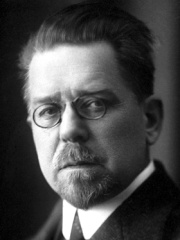
10. Władysław Reymont (1867 - 1925)
With an HPI of 72.79, Władysław Reymont is the 10th most famous Polish Writer. His biography has been translated into 86 different languages.
Władysław Stanisław Reymont (Polish: [vwaˈdɨswaf ˈrɛjmɔnt]; born Rejment; 7 May 1867 – 5 December 1925) was a Polish novelist and the laureate of the 1924 Nobel Prize in Literature. His best-known work is the award-winning four-volume novel Chłopi (The Peasants). Born into an impoverished noble family, Reymont was educated to become a master tailor, but instead worked as a gateman at a railway station and then as an actor in a troupe. His intensive travels and voyages encouraged him to publish short stories, with notions of literary realism. Reymont's first successful and widely praised novel was The Promised Land from 1899, which brought attention to the bewildering social inequalities, poverty, conflictive multiculturalism and labour exploitation in the industrial city of Łódź (Lodz). The aim of the novel was to extensively emphasize the consequences of extreme industrialization and how it affects society as a whole. In 1900, Reymont was severely injured in a railway accident, which halted his writing career until 1904 when he published the first part of Chłopi. Władysław Reymont was popular in communist Poland due to his style of writing and the symbolism he used, including socialist concepts, romantic portrayal of the agrarian countryside and toned criticism of capitalism, all present in literary realism. His work is widely attributed to the Young Poland movement, which featured decadence and literary impressionism.
People
Pantheon has 161 people classified as Polish writers born between 1415 and 1985. Of these 161, 16 (9.94%) of them are still alive today. The most famous living Polish writers include Andrzej Sapkowski, Olga Tokarczuk, and Anita Lasker-Wallfisch. The most famous deceased Polish writers include Günter Grass, Henryk Sienkiewicz, and Wisława Szymborska. As of April 2024, 5 new Polish writers have been added to Pantheon including Joanna Bator, Blanka Lipińska, and Mariusz Szczygieł.
Living Polish Writers
Go to all RankingsAndrzej Sapkowski
1948 - Present
HPI: 73.44
Olga Tokarczuk
1962 - Present
HPI: 70.79
Anita Lasker-Wallfisch
1925 - Present
HPI: 61.30
Adam Michnik
1946 - Present
HPI: 60.73
Hanna Krall
1935 - Present
HPI: 56.92
Christoph Hein
1944 - Present
HPI: 54.24
Ewa Lipska
1945 - Present
HPI: 53.08
Andrzej Stasiuk
1960 - Present
HPI: 51.37
Jacek Dukaj
1974 - Present
HPI: 46.40
Joanna Bator
1968 - Present
HPI: 45.96
Blanka Lipińska
1985 - Present
HPI: 45.44
Mariusz Szczygieł
1966 - Present
HPI: 44.38
Deceased Polish Writers
Go to all RankingsGünter Grass
1927 - 2015
HPI: 80.42
Henryk Sienkiewicz
1846 - 1916
HPI: 79.31
Wisława Szymborska
1923 - 2012
HPI: 78.89
Adam Mickiewicz
1798 - 1855
HPI: 78.60
Janusz Korczak
1878 - 1942
HPI: 77.74
Isaac Bashevis Singer
1902 - 1991
HPI: 77.49
Gerhart Hauptmann
1862 - 1946
HPI: 76.95
Alfred Döblin
1878 - 1957
HPI: 72.90
Władysław Reymont
1867 - 1925
HPI: 72.79
Osip Mandelstam
1891 - 1938
HPI: 72.25
Witold Gombrowicz
1904 - 1969
HPI: 70.40
Christa Wolf
1929 - 2011
HPI: 70.12
Newly Added Polish Writers (2025)
Go to all RankingsJoanna Bator
1968 - Present
HPI: 45.96
Blanka Lipińska
1985 - Present
HPI: 45.44
Mariusz Szczygieł
1966 - Present
HPI: 44.38
Maja Lidia Kossakowska
1972 - 2022
HPI: 39.53
Jacek Dehnel
1980 - Present
HPI: 38.45
Overlapping Lives
Which Writers were alive at the same time? This visualization shows the lifespans of the 25 most globally memorable Writers since 1700.

